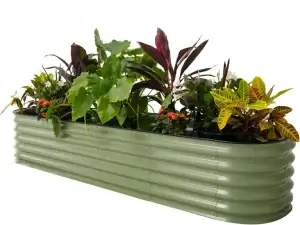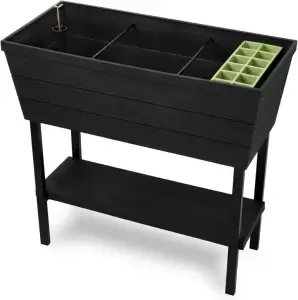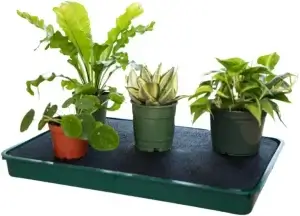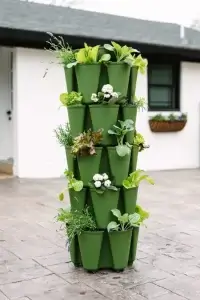Imagine spending more time enjoying your garden and less time maintaining it. Self-watering raised garden beds make this dream a reality by combining elevated planting areas with innovative irrigation systems that keep your plants perfectly hydrated with minimal intervention. These revolutionary gardening solutions have transformed how busy professionals, seniors, urban dwellers, and gardening enthusiasts approach growing their own food.
In this comprehensive guide, we’ll explore how self-watering raised beds work, examine the top 5 options available in 2025, and help you select the perfect system for your specific needs. Whether you’re looking to maximize limited space, reduce your gardening workload, or overcome physical limitations, these smart gardening solutions deserve your attention.
Understanding Self-Watering Raised Garden Bed Technology
Self-watering raised beds represent a significant evolution in home gardening technology. These systems combine the ergonomic advantages of elevated planting with intelligent water management to create optimal growing conditions with minimal effort.
How the Self-Watering Magic Happens
At the heart of these innovative systems is a remarkably simple yet effective mechanism:
- Water Reservoir System: Each bed contains a dedicated water storage chamber at the base that holds several gallons of water.
- Capillary Action Technology: Through specialized wicking channels, water moves upward from the reservoir into the soil through capillary action – the same natural process plants use to draw water through their roots.
- Consistent Moisture Delivery: Instead of alternating between drought and flood conditions, plants receive steady moisture at optimal levels.
- Simple Refill Process: Most systems feature convenient fill tubes that allow you to replenish the reservoir without disturbing plants or soil.
This self-regulating approach creates ideal growing conditions while dramatically reducing maintenance requirements – a perfect solution for today’s time-pressed gardeners.
Remarkable Benefits for Modern Gardeners
Self-watering raised garden beds offer compelling advantages that traditional gardening methods simply can’t match:
- Dramatic Water Conservation: Reduce water consumption by up to 80% through minimized evaporation and runoff
- Significant Time Savings: Extend watering intervals from daily to weekly (or longer)
- Superior Plant Health: Eliminate stress from inconsistent watering
- Reduced Weed Pressure: Many systems include weed barriers or mulch covers
- Ergonomic Design: Eliminate bending and kneeling with elevated configurations
- Space Optimization: Maximize productivity in limited garden areas
- Extended Growing Seasons: More consistent conditions support earlier planting and later harvests
The 5 Most Innovative Self-Watering Raised Garden Beds of 2025
After thorough evaluation of design quality, user experiences, and performance metrics, these five self-watering raised garden beds represent the best options currently available:
1. Vego Garden Self-Watering System: Premium Durability Champion
What Makes It Exceptional:
The Vego Garden self-watering system represents the pinnacle of durable, customizable raised bed technology. Its modular design and premium materials create a solution that combines longevity with exceptional performance.
Essential Specifications:
- Construction: Heavy-gauge galvanized steel with food-safe powder coating
- Dimensions: Modular system available in 2’×4′, 2’×6′, and 2’×8′ configurations
- Height Options: Standard 17″ with elevated leg extensions available
- Water Capacity: 5-gallon reservoir with integrated fill tube
- Special Features: Anti-rust protection, tool-free assembly, frost-resistant design
- Price Range: $199-$349 depending on configuration
Perfect For: Serious gardeners seeking a premium, long-term investment. The Vego system particularly excels in challenging climates where lesser materials might deteriorate quickly.
Expert Perspective: “The combination of industrial-grade materials with a sophisticated wicking system makes the Vego Garden bed the most durable self-watering option we’ve tested. While the initial investment is higher, the 20+ year lifespan makes it economical over time.” – Modern Gardening Institute

2. Keter Urban Bloomer: Space-Saving Design Master
What Makes It Exceptional:
For those with limited outdoor space, the Keter Urban Bloomer delivers sophisticated self-watering functionality in a compact, stylish package that works beautifully on balconies, patios, and other small spaces.
Essential Specifications:
- Construction: UV-resistant polypropylene with attractive rattan texture
- Dimensions: 32.3″×14.6″×30″ (height)
- Capacity: 12.7 gallons of soil with 3.5-gallon water reservoir
- Special Features: Built-in water level indicator, drainage system, planting shelf
- Weight: Just 13 pounds empty for easy repositioning
- Price Range: $79-$99
Perfect For: Urban gardeners, apartment dwellers, and anyone with limited outdoor space who doesn’t want to compromise on gardening capabilities.
Expert Perspective: “The Urban Bloomer’s intelligent design maximizes growing capacity while minimizing footprint. The integrated water level indicator is particularly valuable for beginners who might otherwise struggle with proper moisture management.” – Small Space Gardening Association

3. Gardener’s Supply Self-Watering Elevated Cedar Planter: Accessibility Excellence
What Makes It Exceptional:
This premium cedar planter combines natural materials with smart water management to create a solution that’s as beautiful as it is practical, all at the perfect working height for comfortable gardening.
Essential Specifications:
- Construction: Naturally rot-resistant cedar with powder-coated aluminum corners
- Dimensions: 48″×24″×33″ (height)
- Capacity: 6-gallon water reservoir with proprietary capillary mat system
- Special Features: Decorative design suitable for visible locations, natural pest resistance
- Assembly: Pre-cut components with simple hardware assembly
- Price Range: $229-$279
Perfect For: Seniors, gardeners with mobility limitations, and those who appreciate natural materials and craftsmanship in their outdoor spaces.
Expert Perspective: “The combination of premium cedar construction and an effective self-watering system makes this an exceptional choice for accessible gardening. The 33″ height eliminates bending entirely, while the natural cedar provides both beauty and durability.” – Accessible Gardening Foundation

4. EarthBox Original Growing System: Proven Performance Leader
What Makes It Exceptional:
With decades of refinement behind it, the EarthBox represents time-tested technology that consistently delivers exceptional results. Its research-backed design focuses on functionality over flash.
Essential Specifications:
- Construction: UV-stabilized food-safe recycled plastic
- Dimensions: 29″×13.5″×11″ (height)
- Capacity: 2.5 cubic feet of soil with 3-gallon water reservoir
- Special Features: Included aeration screen, mulch cover, and fertilizer strips
- Weight: 8 pounds empty for good portability
- Price Range: $59-$79 plus optional accessories
Perfect For: Results-oriented gardeners who prioritize proven performance over aesthetics, particularly those growing vegetables and herbs for maximum yield.
Expert Perspective: “The EarthBox’s closed-system design has been perfected through extensive agricultural research. The included mulch cover and specialized fertilizer system work in concert with the self-watering mechanism to create what might be the most foolproof growing system available.” – Urban Harvest Institute

5. GreenStalk Vertical Garden: Vertical Innovation Leader
What Makes It Exceptional:
The GreenStalk reimagines self-watering technology for vertical spaces, offering remarkable growing capacity in a minimal footprint through an innovative stacked design with gravity-fed irrigation.
Essential Specifications:
- Construction: BPA-free, UV-resistant food-grade plastic
- Dimensions: 19″ diameter × 55″ height (5-tier model)
- Capacity: 42 planting pockets with 5-gallon water reservoir
- Special Features: Gravity-fed watering system, optional rotating base
- Assembly: Stackable design with no tools required
- Price Range: $169-$199 depending on accessories
Perfect For: Ultra-small spaces and gardeners looking to maximize growing capacity in minimal horizontal area, particularly for herbs and greens.
Expert Perspective: “The GreenStalk’s vertical design creates remarkable growing capacity – up to 42 plants – in less than 2 square feet of floor space. The gravity-fed watering system ensures all plants receive equal moisture without complex pumps or electronics.” – Vertical Gardening Technologies

Making an Informed Selection: Key Decision Factors
Choosing the perfect self-watering raised bed requires consideration of several important factors:
Space Availability Assessment
Start by honestly evaluating your available garden space:
- Tiny Spaces (under 10 sq ft): The GreenStalk vertical system or Keter Urban Bloomer
- Small Areas (10-25 sq ft): Single EarthBox or smaller Vego Garden configuration
- Medium Spaces (25-50 sq ft): Multiple EarthBoxes or Gardener’s Supply cedar planter
- Larger Areas (50+ sq ft): Multiple Vego Garden beds in custom configurations
Intended Plant Selection
Different plants have specific growing requirements that should influence your choice:
- Shallow-Rooted Plants (lettuce, herbs, radishes): Any system works well
- Medium-Rooted Vegetables (peppers, bush beans): Standard depths like EarthBox
- Deep-Rooted Crops (tomatoes, zucchini): Deeper systems like Vego Garden
- Mixed Plantings: Consider multi-depth systems or several complementary beds
Construction Material Considerations
Your local climate conditions should guide your material selection:
- Hot, Sunny Climates: Metal beds like Vego Garden resist UV deterioration
- Humid Regions: Naturally rot-resistant cedar in the Gardener’s Supply planter
- Windy Areas: Heavier systems or those with anchor options
- Seasonal Freezing: Materials rated for frost resistance if left outdoors year-round
Investment Considerations
While self-watering beds require more initial investment than traditional gardening, they deliver significant long-term value:
- Budget-Friendly ($50-100): EarthBox systems
- Mid-Range ($100-200): Keter Urban Bloomer, GreenStalk
- Premium ($200-350): Gardener’s Supply Cedar Planter, Vego Garden configurations
Aesthetic Preferences
Since your garden bed will be a visible part of your outdoor space, consider its appearance:
- Natural Look: Gardener’s Supply cedar offers traditional garden aesthetics
- Contemporary Design: Keter Urban Bloomer with its modern rattan texture
- Functional Focus: EarthBox prioritizes performance over appearance
- Industrial Modern: Vego Garden’s metal construction creates a modern statement
Optimizing Your Self-Watering Garden Success
To maximize results with your self-watering raised bed, follow these expert-recommended practices:
Ideal Positioning Strategy
Proper placement significantly impacts performance:
- Sunlight Requirements: Position for 6+ hours of direct sun for most vegetables
- Accessibility Factors: Ensure easy access to the water reservoir for refilling
- Convenience Considerations: Place near water sources to simplify maintenance
- Wind Protection: Provide shelter from strong winds that increase water consumption
Soil Selection Science
Self-watering beds require specific soil characteristics for optimal performance:
- Avoid Garden Soil: Too dense for proper capillary action
- Select Quality Potting Mix: Provides ideal moisture movement
- Consider This Blend:
- 60% high-quality potting mix
- 20% compost for fertility
- 20% perlite or vermiculite for aeration and drainage
- Add Appropriate Fertilizer: Most self-watering systems benefit from slow-release options
Plant Selection Strategy
While most plants thrive in self-watering environments, these particularly excel:
Vegetable Champions:
- Tomatoes: Produce more consistently with steady moisture
- Peppers: Develop more uniform fruits with fewer issues
- Leafy Greens: Grow lush and tender with consistent hydration
- Cucumbers: Thrive with the reliable moisture these systems provide
Herb Superstars:
- Basil: Produces larger, more flavorful leaves
- Mint Family: Contained growth in perfect conditions
- Cilantro: Less prone to premature bolting
- Chives: Consistent production of tender shoots
Approach With Caution:
- Drought-Loving Plants: Rosemary, thyme and sage prefer drier conditions
- Root Depth Limitations: Consider bed depth for larger plants like corn
- Water-Sensitive Crops: Some plants prefer soil that dries between waterings
Maintenance Mastery: Keeping Your System Performing Perfectly
Even low-maintenance systems require some regular attention:
Seasonal Care Calendar
Spring Preparation
- Clean reservoir and check wicking systems
- Replace or refresh potting mix as needed
- Verify all components are functioning properly
Summer Maintenance
- Monitor water levels more frequently during heat
- Watch for algae in transparent components
- Consider afternoon shade during extreme heat waves
Fall Transition
- Remove spent plants completely
- Clean growing surfaces thoroughly
- Consider cover crops for winter soil protection
Winter Protection
- Empty reservoirs in freezing climates
- Store portable systems in protected areas
- Cover permanent installations in harsh climates
Troubleshooting Common Challenges
Challenge: Algae Development in Reservoir Solution: Add 1 tablespoon of hydrogen peroxide per gallon of water or cover transparent components
Challenge: Mineral Buildup in System Solution: Flush with diluted vinegar solution (1:10 ratio) seasonally
Challenge: Uneven Moisture Distribution Solution: Check for soil compaction and gently loosen with fork if needed
Return on Investment Analysis: Why Self-Watering Makes Financial Sense
While self-watering raised beds require greater initial investment than traditional gardening, they deliver compelling returns:
Water Conservation Mathematics
The efficiency of these systems creates significant resource savings:
- Typical Reduction: 60-80% less water than conventional methods
- Average Savings: 1,000+ gallons per growing season per 4×8′ garden area
- Environmental Impact: Reduced water footprint and conservation of precious resources
Time Efficiency Calculation
Perhaps the most valuable benefit for busy gardeners:
- Traditional Method: Daily watering during growing season (10-15 minutes per session)
- Self-Watering Alternative: Weekly reservoir filling (15-20 minutes per session)
- Seasonal Time Savings: 30+ hours of active gardening time
- Vacation Freedom: Travel without complex irrigation arrangements
Productivity Measurement
Research consistently demonstrates yield advantages:
- Typical Yield Increase: 20-30% higher production than conventional methods
- Failure Rate Reduction: Fewer crop losses from inconsistent care
- Season Extension: Earlier spring planting and later fall harvests in many climates
Conclusion: Finding Your Perfect Self-Watering Solution
Self-watering raised garden beds represent the intersection of sustainability, convenience, and productivity in modern gardening. By providing consistent moisture, reducing water waste, and minimizing maintenance, these innovative systems allow anyone—from beginners to experienced gardeners—to grow abundant produce with less effort.
Whether you choose the premium durability of the Vego Garden system, the accessible design of Gardener’s Supply cedar planter, or the space-saving innovation of the GreenStalk vertical grower, self-watering technology can transform your gardening experience. Consider your space, budget, and gardening goals to select the perfect system for your needs.
Your ideal gardening solution combines the right technology with your specific situation. Which of these innovative self-watering systems aligns best with your gardening goals?
What factors are most important to you when selecting a raised garden bed? Share your thoughts in the comments below!

